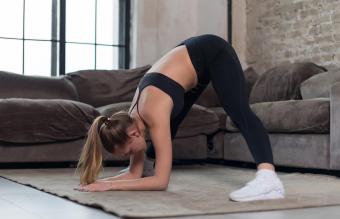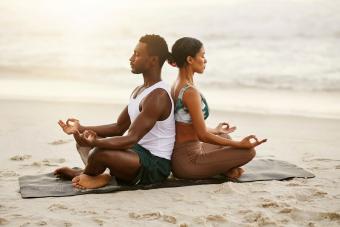
Hatha Yoga is the physical foundation of any yoga practice. Many paths of yoga performed incorporate the founding principles of this grandparent to the craft, designed to open, strengthen and cleanse the body. Many yogis first master Hatha Yoga, then, as the body has become conditioned to the discipline, proceed to more challenging styles of yoga to awaken the mind and spirit more fully.
Understanding the Practice
According to Yoga Journal, the translation of Hatha Yoga in Sanskrit is "ha" - meaning sun; "tha" - meaning moon; and "yoga" - a word translated as union, yoke or power.
This timeline indicates that Hatha originated in approximately the 11th century A.D. in India. Considered the more scientific path of yoga, it is compromised of a basic triad to encourage eventual transformation of body and mind: postures/poses, also referred to as asanas; breath control, or pranayama; and finally, cleansing techniques, or shodhana.
This form of the practice is what most people will do when they sign up for a beginning yoga class in North America. Instructors and practitioners can modify Hatha yoga asanas to accommodate various fitness levels, a method not accepted by other yoga style purists. Asanas can be as simple as lying on the floor (corpse pose) or involve twisting, stretching and reaching.
Once the physical discipline is perfected, students will attain new heights of awareness through increased concentration and meditation. As exercisers branch off into other forms of more rigorous yoga, such as Ashtanga, Bikram or Kundalini, they use the base tenets of Hatha to advance within the stages of their new path.
The Eight Steps
This style of yoga can also be explored to great lengths in order to control a restless mind, reduce stress and enjoy peace. The Divine Life Society details that the methodology of the exact practice of Hatha is broken down into eight limbs, or steps:
- Yamas: explores truth, morals and personal conduct
- Niyamas: contentment, surrender of the ego
- Asanas: steady poses
- Pranayama: control of breath and vital energy; together with asanas, the most common Western practice of Hatha yoga
- Pratyahara: withdrawal of the senses
- Dharana: mastering concentration
- Dhyana: examines meditation
- Samadhi: experiencing the super-coconscious state
Who Is B.K.S. Iyengar?
A name that frequently comes up in conjunction with Hatha Yoga is B.K.S. Iyengar. Considered to be one of the first yogis to introduce the practice to the United States, he used his version of Hatha, known as Iyengar Yoga, to place emphasis on proper alignment during asanas.
When practicing Iyengar Yoga, exercisers can also incorporate the aid of yoga props developed by Iyengar to allow students to extend further into certain yoga postures and compose form without injury.
Iyengar also wrote one of the premiere books on yoga, Light on Yoga: The Bible of Modern Yoga, in 1966. This guide is still used for guidance and instruction by yogis all over the world.
Effects of Hatha Yoga
Like many yogic postures, asanas are broken down into purposeful movements, often in a particular sequence. Within reason, anyone at any age can perform the poses. According to The National Center for Complementary and Alternative Medicine, yoga may provide many physical, mental, and emotional benefits.
Physical improvements include:
- Toned and strengthened muscles
- Flexibility in the spine and joints
- Increased flow of blood and oxygen
- Improved digestion
- Better balance and posture
The Yoga Therapy Center indicates many doctors have also noticed that their patients who practice Hatha Yoga reduce symptoms of arthritis and chronic fatigue, among other conditions.
The mental and emotional effects of practicing Hatha Yoga are quite varied. Through a dedicated and disciplined approach to the exercise, many claim to experience:
- Relief from stress
- Increased ability for concentration
- Deeper relaxation and sleep
- Expanded consciousness and awareness
Yoga Classes, DVDs and Books
Before starting any form of exercise, talk with your physician and research the practice. In addition, it's always best to first perform any yoga path under the guidance of an experienced teacher, who will not only teach you about the history and theory of the style, but also instruct and correct your postures and other physical attributes important to the practice and to avoid injury.
In addition to checking with a local fitness club or spa, the following resources can help you find teachers and classes in your area:
No one source can ever provide a complete, unaltered view of a specific yoga method. But the following books and electronic media may assist with further study:
- Yoga Journal's Yoga for Beginners features Patricia Walden in a 60-minute yoga practice, plus an in-depth interview and bonus flexibility workout. A good introduction to Iyengar Yoga, this workout covers standing poses, forward bends, seated poses and inverted poses.
- Body Wisdom's Yoga Three-Pack DVD features a variety of workouts so the student can customize a workout to his or her schedule or physical requirements.
- Anatomy of Hatha Yoga is an informative look at the physicality of the human body in relation to yoga.
- Hatha Yoga Illustrated presents asanas from beginning to end in this comprehensive book of almost 650 full-color photographs.







